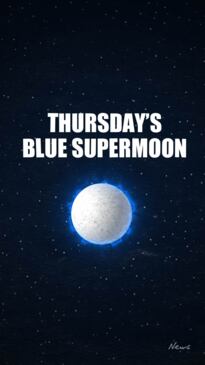[ad_1] Stargazers are in for a treat with a rare “super blue moon” set to grace the night sky across Australia later this week.The astronomical even
[ad_1]
Stargazers are in for a treat with a rare “super blue moon” set to grace the night sky across Australia later this week.
The astronomical event will be visible from Australia on August 31, and involves both a supermoon and a blue moon.
The striking occurrence is the first since in 14 years, but is also the last time such an event will be seen for some time.

The next blue moon will not occur until May 2026, while the next super blue moon will not be until sometime in 2029.
Despite the name, the term “super blue moon” refers neither to the colour nor intensity of the full moon itself.
Instead, a “blue moon” denotes the frequency of a full moon, though exact definitions differ between agencies.
“The time between super blue moons is quite irregular ― it can be as much as 20 years ― but in general, 10 years is the average,” a post on NASA’s website states.
A supermoon, meanwhile, refers to when the moon’s orbit is closest to earth at the same time that it is full.
US space agency NASA said that despite differing thresholds for a blue moon event, two full moons in August qualify.
Like the common phrase suggests, blue moons are relatively rare occurring only once every two to three years.
The full moon will also correspond with the Hindu festival Raksha Bandhan, also called Rakhi or Rakhi Purnima.
The festival celebrates the bond between brothers and sisters, and is commemorated by the tying of a cotton bracelet.
The moon also comes after an August “sturgeon moon” in late-July, named after the fish of the same name.
Saturn – near to its brightest state – will also be located nearby to the moon during the super blue moon, according to NASA.
How to see the super blue moon?
The moon will peak shortly before midday on Thursday, when unfortunately it will not be visible in Australia skies.
Stargazers will nonetheless see the moon appear larger and brighter when it begins to rise from 5.46pm on Thursday.
Swinburne University’s Dr Sara Webb told The Guardian the moon will also look “exceptionally full” on Wednesday and Friday.
As for the rest of the year, the remaining full moons are:
- August 31: Blue moon
- September 29: Harvest moon
- October 28: Hunter’s moon
- November 27: Beaver moon
- December 26: Cold moon
[ad_2]
Source link



COMMENTS